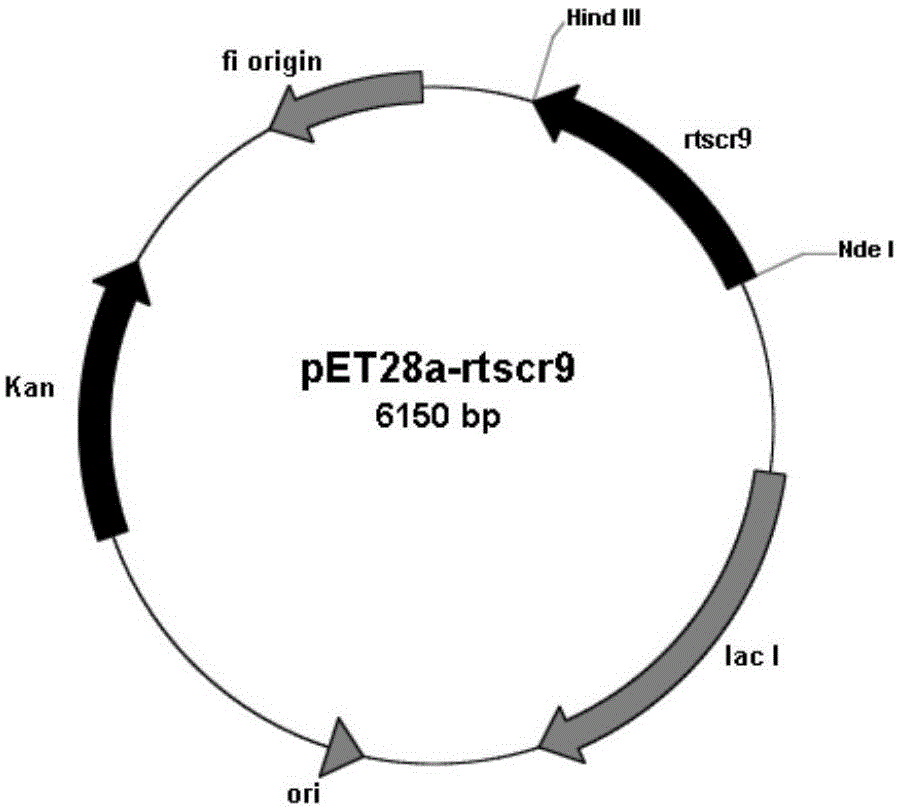Carbonyl reductase gene, codase, vector, strain and application of gene
A technology of carbonyl reductase and reductase, which is applied in the direction of oxidoreductase, application, genetic engineering, etc., can solve the problem of low catalytic efficiency
- Summary
- Abstract
- Description
- Claims
- Application Information
AI Technical Summary
Problems solved by technology
Method used
Image
Examples
Embodiment 1
[0050] Example 1 Acquisition of Rhodosporidium toruloides (Rhodosporidium toruloides) ZJB2014212
[0051] The present invention takes soil samples from Zhejiang, Hubei, Anhui, Jiangsu and other places, and takes 30 soil samples altogether. The specific method of screening: Weigh 5g of soil sample, add 50mL of sterile water to make soil suspension, take 1.0mL of supernatant, add it to the screening medium, shake and cultivate at 30°C, 150rpm / min on a shaker for 48h. Take the culture solution for gradient dilution, take 10 -5 、10 -6 and 10 -7 Gradient dilutions of the above samples were spread on LB solid medium, and cultured in a constant temperature incubator at 30°C for 48 hours. The grown single colony was picked and inoculated into the liquid fermentation medium for cultivation. Cultivate on a shaker at 30°C for 48 hours, collect the cells by centrifugation, and wash with phosphate buffer. The cells are used for transformation, and the transformation conditions are as ...
Embodiment 2
[0062] Example 2: Amplification of the carbonyl reductase gene rtscr9
[0063]According to the whole genome sequencing information of Rhodosporidium toruloides (Rhodosporidium toruloides) ZJB2014212, carbonyl reductases with potential catalytic activity were excavated, one of which has the ability to catalyze N,N-dimethyl-3-keto-3-(2-thienyl)propane The enzyme with the function of generating (S)-N,N-bismethyl-3-hydroxyl-3-(2-thienyl)propionamide from amide hydrochloride is the carbonyl reductase RtSCR9 involved in the present invention.
[0064] Using Ambion's The reagents were used to extract the total mRNA of Rhodosporidium toruloides ZJB2014212 cells. 1 mg mRNA was taken as a template, and cDNA was synthesized by reverse transcription using the ReverTraAceqPCRRT kit (ToYoBo, Japan). Using the cDNA as a template, PCR amplification was performed under the action of primer 1 (ATGTCTTCGCCTACTCCCAACGTC) and primer 2 (CTACCATGGCAAGAACGTCCCGTC). PCR reaction system (total volu...
Embodiment 3
[0067] Embodiment 3: Construction of recombinant Escherichia coli BL21(DE3) / pET28a-rtscr9
[0068] Design expression primer 3 ( catatg TCTTCGCCTACTCCCAACGTC), primer 4 ( aagctt CTACCATGGCAAGAACGTCCCGTC), and NdeI and HindIII restriction enzyme sites (underlined) were introduced into primer 3 and primer 4, respectively. Under the priming of primer 3 and primer 4, utilize high-fidelity PfuDNA polymerase to amplify, obtain the carbonyl reductase gene sequence (its nucleotide sequence is as shown in SEQIDNO: 1) of length 759bp, use NdeI and HindIII after sequencing The amplified fragment was treated with a restriction endonuclease (TaKaRa), and the fragment was ligated with the commercial vector pET28a (Invitrogen) treated with the same restriction endonuclease using T4 DNA ligase (TaKaRa) to construct an expression vector pET28a-rtscr9. The constructed expression vector pET28a-rtscr9 was transformed into Escherichia coli BL21(DE3) (Invitrogen), spread on LB plates containing...
PUM
 Login to View More
Login to View More Abstract
Description
Claims
Application Information
 Login to View More
Login to View More - R&D
- Intellectual Property
- Life Sciences
- Materials
- Tech Scout
- Unparalleled Data Quality
- Higher Quality Content
- 60% Fewer Hallucinations
Browse by: Latest US Patents, China's latest patents, Technical Efficacy Thesaurus, Application Domain, Technology Topic, Popular Technical Reports.
© 2025 PatSnap. All rights reserved.Legal|Privacy policy|Modern Slavery Act Transparency Statement|Sitemap|About US| Contact US: help@patsnap.com



